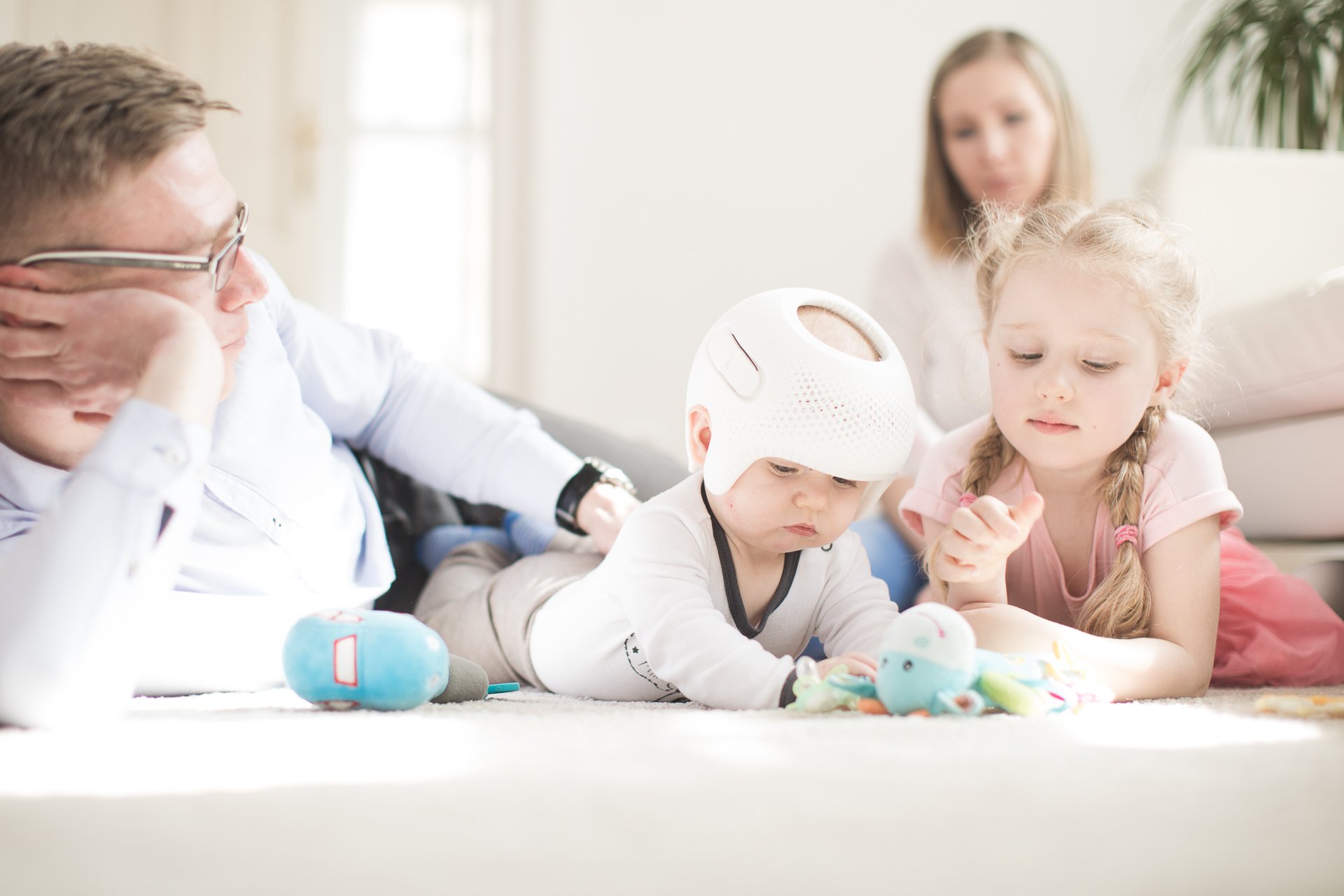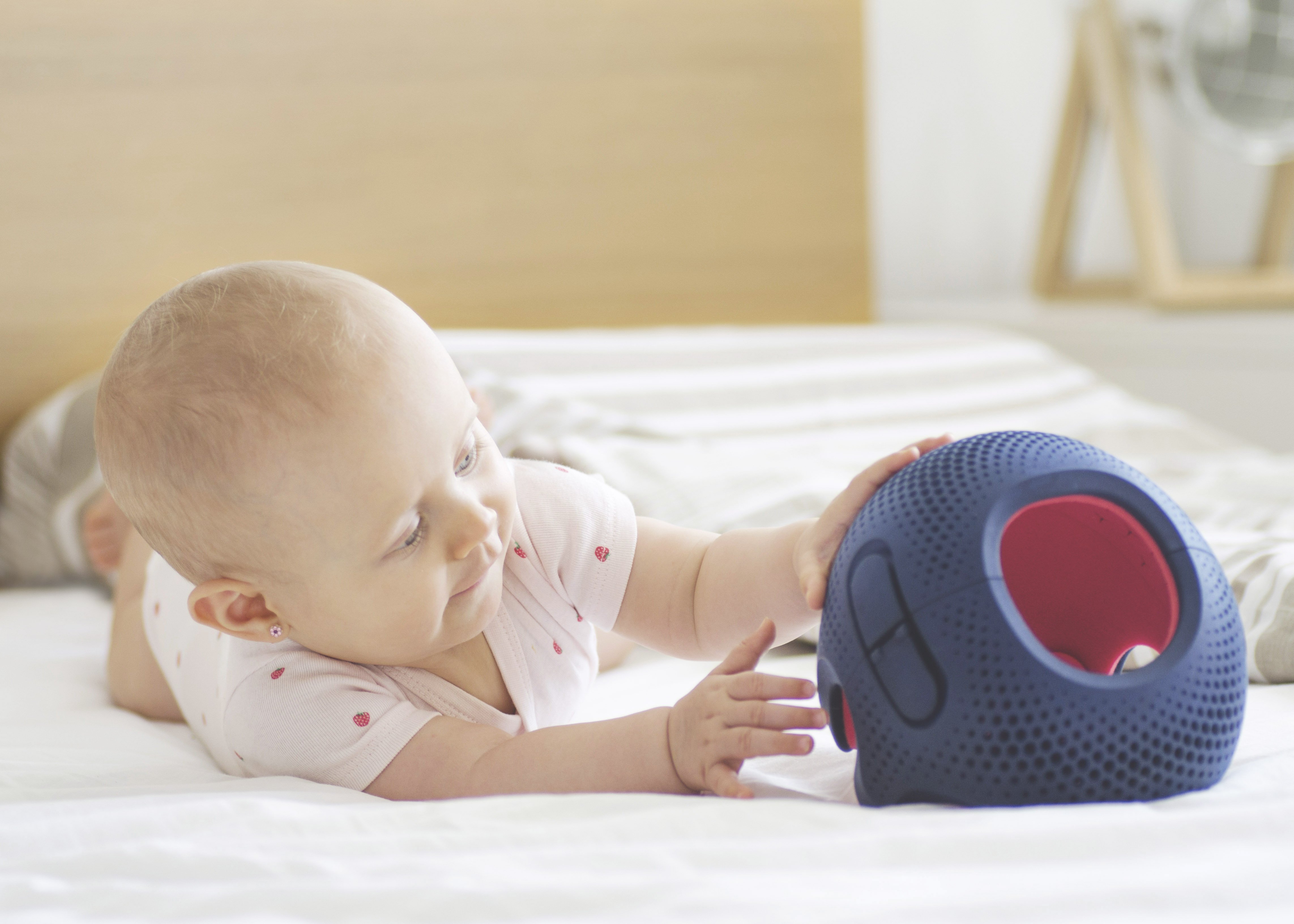
1. Congenital Muscular Torticollis
If your baby regularly has their head tilted to one side, this may be caused by torticollis.
Torticollis, also known as wryneck, is a condition involving the muscles of the neck responsible for allowing the head to tilt down. Torticollis occurs when there is a small knot of tangled fibres in one of the side neck muscles, known as the sternocleidomastoid muscle (SCM). This tangled knot means the sternocleidomastoid muscle is shorter on one side of the neck than the other, causing the head to tilt in the direction of the shorter muscle. Watch our YouTube video for a full explanation of the condition.
If your baby has torticollis at birth, it’s referred to as congenital muscular torticollis and is the most common type. This knot in the SCM can develop whilst the baby is still in the womb and is a result of being cramped or being in an abnormal position, such as breech position. In turn, this can put extra pressure on one side of your baby’s head, which can cause the SCM to tighten.
Torticollis is usually detected within the first few weeks of a baby’s life when a paediatrician or the midwife/health visitor notices a small lump on the side of the baby’s neck. Similarly, it can be detected by parents who notice that their baby’s head leans to one side and subsequently contacts a clinician. Our previous blog post outlines what to do if your baby has torticollis.
2. Acquired Torticollis
When a baby develops torticollis after birth, this is known as ‘acquired torticollis’. Acquired torticollis can develop as the result of a tricky birth (particularly with breech and difficult first-time deliveries), or as a result of a shortening that has developed from the position that your baby has been lying in.
You might not notice anything unusual about your baby at first as it’s common for torticollis symptoms to become obvious once an infant gains more control of their head and neck. Rather than finding a newborn head tilts to one side, you might notice some signs later on, such as:
- Infant tilting head to one side with their chin pointing towards the opposite shoulder. The right side is affected by roughly 75% of babies with torticollis so if your baby’s head tilts to the right side, this may be the cause.
- Your baby has trouble turning their head up and down and side to side.
- There is a soft lump in your baby’s neck muscle.
- Your baby starts getting flat areas on one or both sides from lying in one position all the time- this is called ‘positional plagiocephaly’.
Please read our blog post on how to prevent plagiocephaly developing in infants if you are worried about flat head syndrome as a result of torticollis. We also explain the relationship between plagiocephaly and torticollis.
3. Klippel-Feil Syndrome
This condition is present from birth. If your baby keeps tilting their head to one side, they may have Klippel-Feil Syndrome which is the result of a fusion of two or more cervical (neck) vertebrae. Children with Klippel-Feil syndrome may have a short, broad neck, low hairline and very restricted neck movement. If you’re not sure about your newborn’s head, please read 5 things about your newborn’s head that are completely normal.
Klippel-Feil Syndrome is a rare disorder, estimated to affect 1 in 40,000 newborns worldwide. The disorder appears to occur slightly more often in females than in males.If you would like to read more on the disorder, BMJ Best Practice has an explanation and summary available.
Treatments for Infant Head Tilt
Torticollis Treatment
Treatment is the same for both congenital and acquired torticollis. It involves some simple stretching exercises to ease the short and cramped muscle. These exercises can be done at home, and you can take a look at our guide for 5 Exercises to Improve Torticollis. It can be distressing for parents to see their baby tipping their head to one side and having to perform these improvement exercises; contact a paediatric physiotherapist, osteopath or chiropractor for extra support and guidance.
It’s not uncommon for babies to be diagnosed with torticollis and plagiocephaly, and we’ve written an informative blog post all about the relationship between torticollis and plagiocephaly. If you think your baby has both of these conditions, contact Technology in Motion for advice.
For most babies, torticollis isn’t painful, just uncomfortable when it comes to neck movements. However, it does need to be treated early in order to prevent any long term problems for your baby. Such long term problems include having less control of their head, delays in walking or sitting, poor balance, and problems feeding.
Once torticollis is diagnosed and stretching exercises begin, most babies will improve within 6 months. To speed up recovery, early diagnosis and adherence to the treatment plan are crucial. If your baby or toddler is tilting their head to one side, torticollis treatment may be a solution.
Klippel-Feil Syndrome Treatment
In order to treat Klippel-Feil Syndrome, a specialist may recommend treatments ranging from physiotherapy to an operation to relieve cervical and craniocervical instability and constriction of the spinal cord. It is NOT corrected by stretches and needs to be managed within a hospital setting.
If your baby is tipping their head to one side, don’t worry. It’s more than likely due to torticollis and there are some simple techniques to correct this. Learn more about torticollis.
We also have a blog post on physiotherapy for plagiocephaly and torticollis which may be of interest to parents whose baby tilts their head to the side. Similarly, if you are worried when your baby holds their head to one side, do not hesitate to get in touch and our dedicated staff will be more than happy to give you any advice and reassurance.


